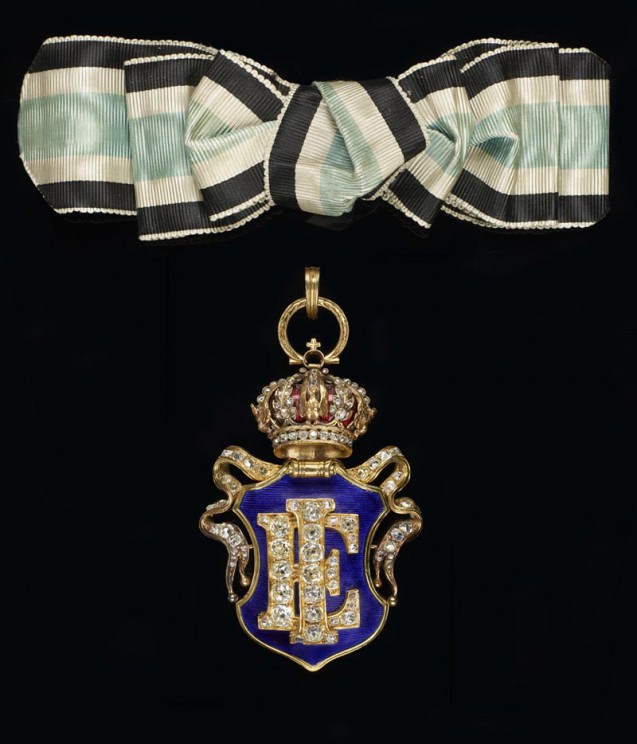The jewellery worn by the Ladies in Waiting or Dames of Empress Eugenie’s Household are indicative of the sumptuous nature of the Empire and the brilliant technicity of French jewellery. The broach here also had a practical use: unlike the men in service to the crown, the ladies had no uniform. A specific broach was thus created so as to be able to identify the role and rank of the wearer. This here is made of gold and enamel, decorated with brilliants and marked with the Empress’ cypher and the imperial crown. It is nine centimetres tall, five centimetres wide, and hangs on a ribbon.
This broach was worn by the Princess d’Essling (in this painting by Winterhalter, the Empress is offering a branch of honeysuckle to the Princesse d’Essling, dressed in pink and sitting to her right), Grande Maîtresse (principal lady in waiting) of the Empress’ Household during the whole of the Second Empire. The princess, born Anna Debelle (1802-1887), married François Victor Masséna (1799-1863), Duc de Rivoli and Prince d’Essling in 1823. The comtesse Des Garets in her memoirs, Souvenirs d’une demoiselle d’honneur, records how forcefully struck she was by Anna’s imposing formality: I have «never seen a person so completely feudally tied to her role. I do not know if she had a soul, if she had a heart, or if she could be moved or emotional; she was the Grande Maîtresse!»
In addition to the Grande Maîtresse, the Empress’ household comprised a second-in-command, Dame d’Honneur (Matron of Honour) – the Duchesse de Bassano, up to 1867, and then the Comtesse Colonna Walewska –, a Lectrice or female reader, a Demoiselle d’Honneur (Maid of Honour) and of course the Dames du Palais (Ladies in Waiting), of which there were seven every year, rising to twelve from 1855 when the Empress’ Household increased because of the Empress’ pregnancy and the birth of the Prince Impérial.
In 1868, at the Empress’ request, Alexandre Cabanel executed the portrait of Amélie Carette, née Bouvet, initially Demoiselle d’Honneur and then Dame du Palais. In her memoirs, Souvenirs intimes de la Cour des Tuileries Madame Carette recounted this story of this painting. «It was after my marriage. She [the Empress] urged me to ask Cabanel to paint my portrait, since she wanted to see how well he would do it, and then to ask him to do hers; it was to be the last, she said, that she wanted to leave of her. Cabanel did my portrait, but he did not do that of the Empress: events intervened, and the project was abandoned». In this portrait by Cabanel, today held at the Palais de Compiègne, Madame Carette wears a very plain dark blue dress. The contour of the décolleté is marked by a band of dark fur, and pinned to one shoulder, almost the only light in the picture, the painter had placed the brooch with the Empress Eugenie’s cypher, the symbol of belonging to the sovereign’s household and the only jewel in the painting.
Xavier Mauduit
April 2018
This brooch was shown at the exhibition «Art in the service of power» at the Atelier Grognard in Rueil-Malmaison (2018).


